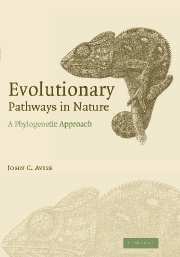Book contents
- Frontmatter
- Contents
- Preface
- Acknowledgments
- 1 Introduction
- 2 Anatomical structures and morphologies
- 3 Body colorations
- 4 Sexual features and reproductive lifestyles
- 5 More behaviors and ecologies
- 6 Cellular, physiological, and genetic traits
- 7 Geographical distributions
- Epilog
- Appendix: a primer on phylogenetic character mapping
- Glossary
- References and further reading
- Index
2 - Anatomical structures and morphologies
Published online by Cambridge University Press: 18 December 2009
- Frontmatter
- Contents
- Preface
- Acknowledgments
- 1 Introduction
- 2 Anatomical structures and morphologies
- 3 Body colorations
- 4 Sexual features and reproductive lifestyles
- 5 More behaviors and ecologies
- 6 Cellular, physiological, and genetic traits
- 7 Geographical distributions
- Epilog
- Appendix: a primer on phylogenetic character mapping
- Glossary
- References and further reading
- Index
Summary
Perhaps the most obvious characteristics for PCM are those readily visible to the human eye as morphological or anatomical variations among related species. Indeed, the number of published PCM studies involving macroscopic body features (such as beak shapes, limb configurations, and body morphs) probably exceeds the numbers for any other single category of organismal traits (e.g. behaviors, physiologies, or ecologies). This chapter will examine several case studies in which especially puzzling and even bizarre morphological phenotypes have been the subjects of PCM.
Whence the toucan's bill?
About 40 species of toucan (Ramphastidae) inhabit portions of New World forests from southern Mexico to northern Argentina and Paraguay. Their most prominent feature is a colorful bill, which can be nearly as long as the bird's body. This protuberance is so outlandish that a toucan flying through a pasture or woodland can look like a silly clown pushing a banana along in front of its face. Despite its size, a toucan's bill is light and can be dexterously employed to plunder eggs or hatchlings from another bird's nest, or to pluck fruits that make up an important part of the toucan's diet. However, the spectacular colors of toucans' bills are thought to serve primarily in mate attraction or mate recognition during courtship. Thus, the toucan's bill probably evolved its impressive features via sexual selection (selection directly related to mate acquisition) as well as natural selection.
- Type
- Chapter
- Information
- Evolutionary Pathways in NatureA Phylogenetic Approach, pp. 19 - 51Publisher: Cambridge University PressPrint publication year: 2006



